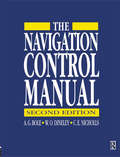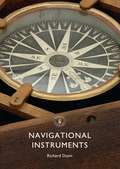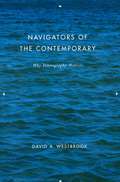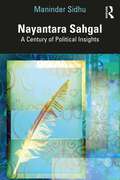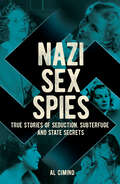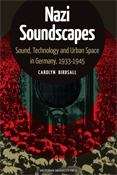- Table View
- List View
Navigating Time and Space in Population Studies (International Studies in Population #9)
by Emily R Merchant, Glenn D Deane, Myron P Gutmann and Kenneth M SylvesterNavigating Time and Space in Population Studies presents innovative approaches to long-standing questions about the diffusion of population and demographic behavior across space and over time. This collection utilizes newly-available historical data along with spatially and temporally explicit analytical methods to evaluate and refine core demographic theories and to pose new questions about mortality and fertility transitions, migration, urbanization, and social inequality. It adds a spatial dimension to the analysis of temporal processes and a temporal element to spatial processes. Chapters cover a broad range of geographical settings, including the United States, Europe, Latin America, and the Islamic world, and span time periods from the eighteenth to twentieth century. Contributors from a variety of disciplines reveal the complexity of factors involved in population processes that spread across space and unfold over time, and demonstrate a rich set of tools with which to explore, analyze, and test the spatial and temporal dynamics of these phenomena. The theories, methods, and substantive findings presented here provide new lenses through which to view time and space in population studies, offering useful models and valuable insights to demographers and other social scientists exploring both historical and contemporary questions about population dynamics anywhere in the world.
Navigating Uncertainty: Radical Rethinking for a Turbulent World
by Ian ScoonesUncertainties are everywhere. Whether it’s climate change, financial volatility, pandemic outbreaks or new technologies, we don’t know what the future will hold. For many contemporary challenges, navigating uncertainty – where we cannot predict what may happen – is essential and, as the book explores, this is much more than just managing risk. But how is this done, and what can we learn from different contexts about responding to and living with uncertainty? Indeed, what might it mean to live from uncertainty?Drawing on experiences from across the world, the chapters in this book explore finance and banking, technology regulation, critical infrastructures, pandemics, natural disasters and climate change. Each chapter contrasts an approach centred on risk and control, where we assume we know about and can manage the future, with one that is more flexible, responding to uncertainty. The book argues that we need to adjust our modernist, controlling view and to develop new approaches, including some reclaimed and adapted from previous times or different cultures. This requires a radical rethinking of policies, institutions and practices for successfully navigating uncertainties in an increasingly turbulent world.
Navigating Uncertainty: Radical Rethinking for a Turbulent World
by Ian ScoonesUncertainties are everywhere. Whether it’s climate change, financial volatility, pandemic outbreaks or new technologies, we don’t know what the future will hold. For many contemporary challenges, navigating uncertainty – where we cannot predict what may happen – is essential and, as the book explores, this is much more than just managing risk. But how is this done, and what can we learn from different contexts about responding to and living with uncertainty? Indeed, what might it mean to live from uncertainty?Drawing on experiences from across the world, the chapters in this book explore finance and banking, technology regulation, critical infrastructures, pandemics, natural disasters and climate change. Each chapter contrasts an approach centred on risk and control, where we assume we know about and can manage the future, with one that is more flexible, responding to uncertainty. The book argues that we need to adjust our modernist, controlling view and to develop new approaches, including some reclaimed and adapted from previous times or different cultures. This requires a radical rethinking of policies, institutions and practices for successfully navigating uncertainties in an increasingly turbulent world.
Navigating War, Dissent and Empathy in Arab/U.S Relations: Seeing Our Others in Darkened Spaces
by Osman LatiffThis book focuses on American political discourse connected to war, dissent, and empathy. Through interdisciplinary methods of history, politics and media studies, the book examines ways in which American self-identity alters as a consequence of media portrayal of human suffering and of its existential others. It compares representations of the Iraq wars to earlier precedents and looks at the work of American activists, assessing how narratives and images of human suffering in new media iconography generate empathic attitudes towards others. This comparative, multimodal study helps to explain shifting self-identities within the U.S, and relationally through the representation of the Arab other presenting an original and historicised contribution to the media-war field of academic and public debate. The book underscores empathy as a vibrant category of analysis that expands how we think about West-Arab relations, revealing how understanding the cultural aspects of this conflictual interrelationship needs to be broadened.
Navigating Womanhood in Contemporary Botswana
by Stephanie S. StarlingExploring the social construction of womanhood in Tswana culture, this book questions how gendered expectations are shifting in the context of a rapidly changing environment. Seismic social change is underfoot in Botswana, and gender relations are in flux. The government's enactment of extensive legal reforms, national programmes, and international instruments has gone a long way towards ensuring gender equality on an official basis. However, conventionally defined gender roles continue to present major obstacles for women.This book explores what it means to be a woman today in Botswana. The concept of womanhood as a mark of status and responsibility is interrogated, and the social consequences of failing to meet the criteria for womanhood are explored. Stephanie S. Starling considers the multiple and often contradictory burdens women face, the strategies they employ, and the sacrifices they make to meet their obligations. Caught between traditional expectations and modern desires, women share stories of agency, creativity and struggle in defining their own paths. A reflexive account of the fieldwork is presented. confronting the ethical challenges of cross-cultural research from a feminist standpoint.
Navigating Womanhood in Contemporary Botswana
by Stephanie S. StarlingExploring the social construction of womanhood in Tswana culture, this book questions how gendered expectations are shifting in the context of a rapidly changing environment. Seismic social change is underfoot in Botswana, and gender relations are in flux. The government's enactment of extensive legal reforms, national programmes, and international instruments has gone a long way towards ensuring gender equality on an official basis. However, conventionally defined gender roles continue to present major obstacles for women.This book explores what it means to be a woman today in Botswana. The concept of womanhood as a mark of status and responsibility is interrogated, and the social consequences of failing to meet the criteria for womanhood are explored. Stephanie S. Starling considers the multiple and often contradictory burdens women face, the strategies they employ, and the sacrifices they make to meet their obligations. Caught between traditional expectations and modern desires, women share stories of agency, creativity and struggle in defining their own paths. A reflexive account of the fieldwork is presented. confronting the ethical challenges of cross-cultural research from a feminist standpoint.
Navigating Women’s Friendships in American Literature and Culture (American Literature Readings in the 21st Century)
by Kristi Branham Kelly L. ReamesThis volume presents a collection of critical essays that center women’s friendship in women’s literary and artistic production. Analyzing cultural portrayals of women’s friendships in fiction, letters, and film, these essays collectively suggest new models of literary interpretation that do not prioritize heterosexual romance. Instead, this book represents friendships as mature and meaningful relationships that contribute to identity formation and political coalition. Both the supportive and competitive aspects of friendships are shown to be crucial to women’s identities as individuals, political citizens, and artists. Addressing the complexities of how 20th- and 21st-century cultural texts construe women’s friendships as they navigate patriarchal institutions, this collection advances scholarship on friendship beyond men and masculine models.
Navigation Control Manual
by A G Bole C E Nicholls W O DineleyInvaluable to participants of navigation control courses, candidates for Class 2 and Class 1 (master mariner) and all practising navigating officers.
Navigation Control Manual
by A G Bole C E Nicholls W O DineleyInvaluable to participants of navigation control courses, candidates for Class 2 and Class 1 (master mariner) and all practising navigating officers.
Navigational Instruments (Shire Library)
by Richard DunnWith over two-thirds of the globe covered by water, the ability to navigate safely and quickly across the oceans has been crucial throughout human history. As seafarers attempted longer and longer voyages from the sixteenth century onwards in search of profit and new lands, the tools of navigation became ever more sophisticated. The development of instruments over the last five hundred years has seen some revolutionary changes, spurred on by the threat of disaster at sea and the possibility of huge rewards from successful voyages. As this book shows, the solution of the infamous longitude problem, the extraordinary impact of satellite positioning and other advances in navigation have successfully brought together seafarers, artisans and scientists in search of better ways of getting from A to B and back again.
Navigators of the Contemporary: Why Ethnography Matters
by David A. WestbrookAs the image of anthropologists exploring exotic locales and filling in blanks on the map has faded, the idea that cultural anthropology has much to say about the contemporary world has likewise diminished. In an increasingly smaller world, how can anthropology help us to tackle the concerns of a global society? David A. Westbrook argues that the traditional tool of the cultural anthropologist—ethnography—can still function as an intellectually exciting way to understand our interconnected, yet mysterious worlds. Navigators of the Contemporary describes the changing nature of ethnography as anthropologists use it to analyze places closer to home. Westbrook maintains that a conversational style of ethnography can help us look beyond our assumptions and gain new insight into arenas of contemporary life such as corporations, financial institutions, science, the military, and religion. Westbrook’s witty, absorbing book is a friendly challenge to anthropologists to shed light on the present and join broader streams of intellectual life. And for those outside the discipline, his inspiring vision of ethnography opens up the prospect of understanding our own world in much greater depth.
Navigators of the Contemporary: Why Ethnography Matters
by David A. WestbrookAs the image of anthropologists exploring exotic locales and filling in blanks on the map has faded, the idea that cultural anthropology has much to say about the contemporary world has likewise diminished. In an increasingly smaller world, how can anthropology help us to tackle the concerns of a global society? David A. Westbrook argues that the traditional tool of the cultural anthropologist—ethnography—can still function as an intellectually exciting way to understand our interconnected, yet mysterious worlds. Navigators of the Contemporary describes the changing nature of ethnography as anthropologists use it to analyze places closer to home. Westbrook maintains that a conversational style of ethnography can help us look beyond our assumptions and gain new insight into arenas of contemporary life such as corporations, financial institutions, science, the military, and religion. Westbrook’s witty, absorbing book is a friendly challenge to anthropologists to shed light on the present and join broader streams of intellectual life. And for those outside the discipline, his inspiring vision of ethnography opens up the prospect of understanding our own world in much greater depth.
Navigators of the Contemporary: Why Ethnography Matters
by David A. WestbrookAs the image of anthropologists exploring exotic locales and filling in blanks on the map has faded, the idea that cultural anthropology has much to say about the contemporary world has likewise diminished. In an increasingly smaller world, how can anthropology help us to tackle the concerns of a global society? David A. Westbrook argues that the traditional tool of the cultural anthropologist—ethnography—can still function as an intellectually exciting way to understand our interconnected, yet mysterious worlds. Navigators of the Contemporary describes the changing nature of ethnography as anthropologists use it to analyze places closer to home. Westbrook maintains that a conversational style of ethnography can help us look beyond our assumptions and gain new insight into arenas of contemporary life such as corporations, financial institutions, science, the military, and religion. Westbrook’s witty, absorbing book is a friendly challenge to anthropologists to shed light on the present and join broader streams of intellectual life. And for those outside the discipline, his inspiring vision of ethnography opens up the prospect of understanding our own world in much greater depth.
Nawabs, Nudes, Noodles: India through 50 Years of Advertising
by Ambi ParameswaranThis is as much the story of Indian advertising as it is about India. Ad veteran Ambi Parameswaran looks at how advertising has evolved, reflecting the country's culture, politics and economy in the last fifty years. From sartorial taste and food habits to marriage and old age, music and language to celebrities and censorship, Ambi examines over a hundred ads to study how the Indian consumer has changed in the past five decades and how advertising and society have shaped each other. Combining anecdote and analyses to give us a slice of modern history, Ambi evaluates the relationship between affluence, aspiration and desire in India. Exploring trends and impacts, he covers the ads that captured the imagination of the entire country. From 'Only Vimal' and 'Jai Jawan Jai Kisan' to 'Jo biwi se kare pyaar' and the controversial Tuffs shoes campaign, the book is a memorable journey through brands, consumers and the world of advertising.
Nayantara Sahgal: A Century of Political Insights
by Maninder SidhuThis book is a comprehensive critical re-reading of Nayantara Sahgal’s oeuvre. One of the most significant Indian English writers, her fictional and non-fictional engagement with historical events and political dilemmas inextricably links her to the colonial, anti-colonial and post-colonial discourse in India. Drawing transcontinental connections with the ideas of Fanon, Foucault, Said, Beauvoir, White, Beck and Habermas the monograph juxtaposes recurring themes in her writing with the ideas of significant Indian post-colonial commentators. Tracing the subliminal tendencies in her writing to Gandhian humanity and Nehruvian pragmaticism, the book moves beyond clichés of feminist criticism and genealogical ties to unveil a unique artist who has folded nearly a century of Indian experience in her work. Drawing on novels, essays, speeches, journalism and interviews by Nayantara Sahgal, this volume will be of great interest to scholars of South Asian literature, post-colonialism, politics and contemporary history/culture/change.
Nayantara Sahgal: A Century of Political Insights
by Maninder SidhuThis book is a comprehensive critical re-reading of Nayantara Sahgal’s oeuvre. One of the most significant Indian English writers, her fictional and non-fictional engagement with historical events and political dilemmas inextricably links her to the colonial, anti-colonial and post-colonial discourse in India. Drawing transcontinental connections with the ideas of Fanon, Foucault, Said, Beauvoir, White, Beck and Habermas the monograph juxtaposes recurring themes in her writing with the ideas of significant Indian post-colonial commentators. Tracing the subliminal tendencies in her writing to Gandhian humanity and Nehruvian pragmaticism, the book moves beyond clichés of feminist criticism and genealogical ties to unveil a unique artist who has folded nearly a century of Indian experience in her work. Drawing on novels, essays, speeches, journalism and interviews by Nayantara Sahgal, this volume will be of great interest to scholars of South Asian literature, post-colonialism, politics and contemporary history/culture/change.
Nazi and Holocaust Representations in Anglo-American Popular Culture, 1945–2020: Irreverent Remembrance (Palgrave Studies in Cultural Heritage and Conflict)
by Jeffrey DemskyThis book analyzes sensationalized Nazi and Holocaust representations in Anglo-American cultural and political discourses. Recognizing that this history is increasingly removed from contemporary life, it explains how irreverent representations can help rejuvenate the story for successive generations of new learners. Surveying seventy-five-years of transatlantic activities, the work erects counterposing categorizes of “constructive and destructive memorializing,” providing scholars with a new framework for elucidating both this history and its historicization.
Nazi Collaborators on Trial during the Cold War: Viktors Arājs and the Latvian Auxiliary Security Police (The Holocaust and its Contexts)
by Richards PlavnieksThis book is a study of the legal reckoning with the crimes of the Latvian Auxiliary Security Police and its political dimensions in the Soviet Union, West and East Germany, and the United States in the context of the Cold War. Decades of work by prosecutors have established the facts of Latvian collaboration with the Nazis during the Holocaust. No group made a deeper mark in the annals of atrocity than the men of the so-called 'Arajs Kommando' and their leader, Viktors Arājs, who killed tens of thousands of Jews on Latvian soil and participated in every aspect of the 'Holocaust by Bullets.' This study also has significance for coming to terms with Latvia’s encounter with Nazism – a process that was stunted and distorted by Latvia’s domination by the USSR until 1991. Examining the country’s most notorious killers, their fates on both sides of the Iron Curtain, and contemporary Latvians’ responses in different political contexts, this volume is a record of the earliest phases of this process, which must now continue and to which this book contributes.
Nazi Labour Camps in Paris: Austerlitz, Lévitan, Bassano, July 1943-August 1944
by Jean-Marc Dreyfus Sarah GensburgerOn 18 July 1943, one-hundred and twenty Jews were transported from the concentration camp at Drancy to the Lévitan furniture store building in the middle of Paris. These were the first detainees of three satellite camps (Lévitan, Austerlitz, Bassano) in Paris. Between July 1943 and August 1944, nearly eight hundred prisoners spent a few weeks to a year in one of these buildings, previously been used to store furniture, and were subjected to forced labor. Although the history of the persecution and deportation of France’s Jews is well known, the three Parisian satellite camps have been subjected to the silence of both memory and history. This lack of attention by the most authoritative voices on the subject can perhaps be explained by the absence of a collective memory or by the marginal status of the Parisian detainees - the spouses of Aryans, wives of prisoners of war, half-Jews. Still, the Parisian camps did, and continue to this day, lack simple and straightforward descriptions. This book is a much needed study of these camps and is witness to how, sixty years after the events, expressing this memory remains a complex, sometimes painful process, and speaking about it a struggle.
Nazi-Organized Recreation and Entertainment in the Third Reich (The Holocaust and its Contexts)
by Julia TimpeThis book explores the activities of the Nazi regime's vast leisure programme. Shortly after coming to power in Germany, it began a large-scale undertaking to bring happiness and a good life to so-called 'Aryan' Germans, carried out by the Nazi leisure organization Kraft durch Freude. Julia Timpe traces Kraft durch Freude's practices and propaganda from 1933 through the Second World War, and analyses Nazi-organized sports classes, entertainment events, and beautification campaigns for industrial sites and the countryside, as well as Kraft durch Freude's activities in entertaining German soldiers and concentration camp guards. Contributing to newer scholarship which focuses on the integratory force of the Nazi promise of a unified 'racial community' of all 'Aryan' Germans, this book highlights that Kraft durch Freude's 'everyday production of joy' was central to Nazism, closely connected to the destructive side of the Third Reich, and ultimately a major reason for Nazism's success among the German population.
Nazi Sex Spies: True Stories of Seduction, Subterfuge and State Secrets
by Al CiminoAll is fair in love and war. At least the Nazis thought so. They deployed sex like any other weapon in the service of the Third Reich. Al Camino examines many shocking cases, where brothels were hotbeds of bugging and blackmail, and pillow talk could topple nations. Cases include: • The bugging of Salon Kitty, a high-class brothel in Berlin which was taken over by the SS. • Nazi spy Lilly Stein, a 'good-looking nymphomaniac' who slept with US men in order to blackmail them. • Princess Stephanie Julianne von Hohenlohe, who used her intimate relationship with Lord Rothermere to get the British newspaper Daily Mail to support the Nazis in the 1930s Full of intrigue and surprise, Nazi Sex Spies presents a fascinating history of a little-known aspect of World War II.
Nazi Soundscapes: Sound, Technology and Urban Space in Germany, 1933-1945 (PDF)
by Carolyn BirdsallMany images of Nazi propaganda are universally recognizable, and symbolize the ways that the National Socialist party manipulated German citizens. What might an examination of the party’s various uses of sound reveal? In Nazi Soundscapes, Carolyn Birdsall offers an in-depth analysis of the cultural significance of sound and new technologies like radio and loudspeaker systems during the rise of the National Socialist party in the 1920s to the end of World War II. Focusing specifically on the urban soundscape of Düsseldorf, this study examines both the production and reception of sound-based propaganda in the public and private spheres. Birdsall provides a vivid account of sound as a key instrument of social control, exclusion, and violence during Nazi Germany, and she makes a persuasive case for the power of sound within modern urban history.
Nazi Women of the Third Reich: Serving the Swastika
by Paul Roland• Four months pregnant, Vera Wohlauf, wife of a serving SS officer, took sadistic pleasure in rounding up victims for Treblinka.• Like creatures from a Grimms' fairytale, female members of a Nazi 'welfare' organization scoured the towns and villages of Poland and Slovenia, luring blond children out of hiding with bread and sweets. They were abducted to be raised as Germans by 'Aryan' families who told them their parents were dead.• Test pilot Hanna Reitsch flew on a suicide mission to rescue Hitler from his bunker.• Not even Hitler could resist the charms of Princess Stephanie, a femme fatale and Nazi agent who smoked cigars which she lit by striking a match on the heel of her shoes.The Nazis had no doubts about a woman's place in the Third Reich. Hermann Goering urged every woman to 'take a pot, a dustpan and brush, and marry a man.' Many women welcomed the arrival of Hitler's regime with childlike enthusiasm believing that the dictatorship would make Germany master of Europe, but as the war dragged on, their blind faith in Hitler was betrayed.
Nazis in Newark
by Warren Grover""Well researched, readable, and very interesting"" --Choice ""Nazis in Newark is a model local history that reaches well beyond the border of Essex County, New Jersey, to the national and international arenas. By recounting so many sides of the complicated encounter between Nazis and Jews in Newark, Warren Grover has fashioned a world of street politics, boycotts, Nazi louts and Jewish bruisers that is as compelling and telling in its detail as any grand tome on the supposed failures and successes of American Jewish resistence to the Holocaust... I recommend Nazis in Newark. I intend to use it as a cornerstone of my teaching for some time to come."" --Professor Michael Alexander The Jewish Quarterly Review ""Very few people today realize that the U.S. mainland was the scene of battles against the Nazis. Warren Grover has produced an outstanding work on this subject. The writing is incisive, the ideas are both original and insightful and the thesis masterfully developed and executed. Must reading for anyone interested in American history and ethnic studies."" --William B. Helmreich, CUNY Graduate Center and author of The Enduring Community ""Thanks to tenacious research and deft story-telling, Warren Grover has put the politics of extremism in one city in the shadow of Fascism, Nazism and Communism, and has thus illuminated the terrible dilemmas of the 1930s. His book also compels the reader to consider an historical anomaly: champions of the Third Reich come across as victims whose civil liberties were infringed, and the gangs of Newark responsible for these violations tended to be Jewish. Such ironies make Nazis in Newark worth the interest of anyone intrigued by ethnic conflict and politcal violence in urban America."" --Stephen Whitfield, Max Richter Professor of American Civilization, Brandeis University ""In this fast-paced, thorough study of anti-Nazism in Newark, scholar Warren Grover tells th
Nazis in Newark
by Warren Grover""Well researched, readable, and very interesting"" --Choice ""Nazis in Newark is a model local history that reaches well beyond the border of Essex County, New Jersey, to the national and international arenas. By recounting so many sides of the complicated encounter between Nazis and Jews in Newark, Warren Grover has fashioned a world of street politics, boycotts, Nazi louts and Jewish bruisers that is as compelling and telling in its detail as any grand tome on the supposed failures and successes of American Jewish resistence to the Holocaust... I recommend Nazis in Newark. I intend to use it as a cornerstone of my teaching for some time to come."" --Professor Michael Alexander The Jewish Quarterly Review ""Very few people today realize that the U.S. mainland was the scene of battles against the Nazis. Warren Grover has produced an outstanding work on this subject. The writing is incisive, the ideas are both original and insightful and the thesis masterfully developed and executed. Must reading for anyone interested in American history and ethnic studies."" --William B. Helmreich, CUNY Graduate Center and author of The Enduring Community ""Thanks to tenacious research and deft story-telling, Warren Grover has put the politics of extremism in one city in the shadow of Fascism, Nazism and Communism, and has thus illuminated the terrible dilemmas of the 1930s. His book also compels the reader to consider an historical anomaly: champions of the Third Reich come across as victims whose civil liberties were infringed, and the gangs of Newark responsible for these violations tended to be Jewish. Such ironies make Nazis in Newark worth the interest of anyone intrigued by ethnic conflict and politcal violence in urban America."" --Stephen Whitfield, Max Richter Professor of American Civilization, Brandeis University ""In this fast-paced, thorough study of anti-Nazism in Newark, scholar Warren Grover tells th






